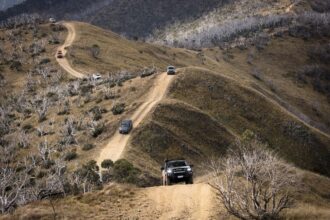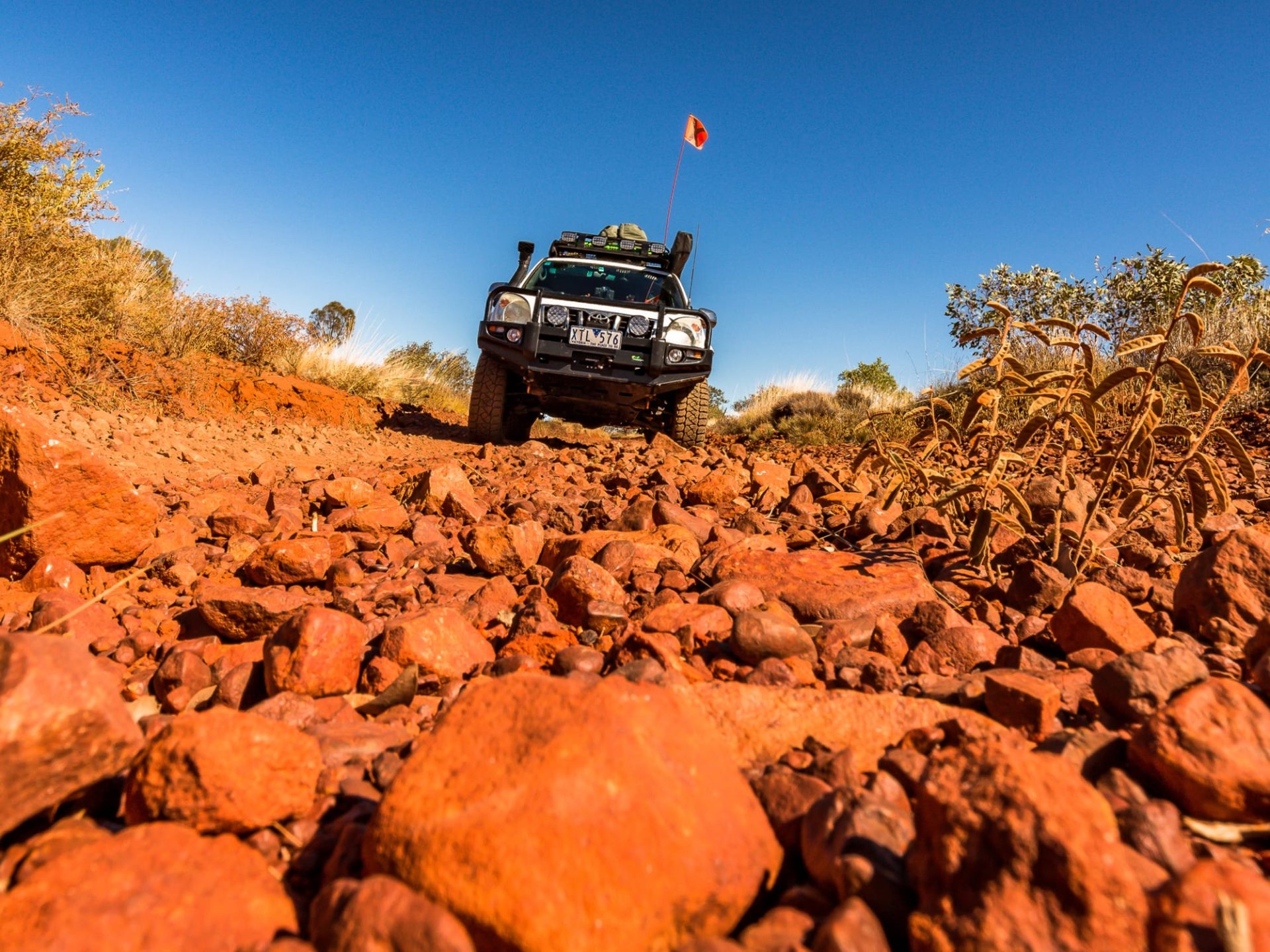Take a selfie, but leave the ‘check-ins’ for Facebook…
Explorer John Stuart first sighted the sandstone column in 1860 – towering 50m above the plain. He decided to name it after a buddy who kicked into Stuart’s travel fund: James Chambers. It has remained a significant landmark on the edge of the Simpson Desert ever since and many passers-by have tagged the rockface as a record of their visit. This is now not permitted thankfully; seeing ‘Craig & Shazza’ carved next to “WM HAYES” doesn’t look right.
Now let’s backtrack a little.
Alice Springs is the hub of the Red Centre and a great place to fuel up, stock up and wash up. Before heading to the ‘local’ for a counter meal, we decided to check out a sunset tour with Pyndan Camel Tracks. The boys settled onto the backs of their dromedary camels while I legged it on foot – easier to take photos that way. We soaked up the serenity as the sun set over the West McDonnell Ranges before returning to camp and readying ourselves for dinner.
Craig had departed first thing and Andre wasn’t flying out until lunchtime. With it being the first time in Alice for Andre, a quick tour was in order after breakfast in the mall.
Anzac Hill is the perfect spot to look over the town of Alice and it was from there we spotted The Ghan sitting at the station. One day I will ride The Ghan, but this time we just walked its 1,019m length (43 carriages and two locos). The smell of rail kill on the front locomotive was putrid; blood and guts splattered everywhere. We dropped Andre at the airport and made it back in time to watch The Ghan leave Alice on its way to Adelaide.
Rod and I departed Alice Springs early next morning. While airing down our tyres, a baby brown snake slid across my boot. It was only 20cm long but we kept our eyes out from then on – where there’s a baby there’s usually a big mother. The South Road was in good condition having been graded after recent rains in preparedness for the Finke Desert Rally.
We explored the Ewaninga Rock Carvings, one of Central Australia’s earliest and richest art sites. The petroglyphs are a sacred site for aboriginal men so photographs aren’t allowed to be taken. The 300m walk is graded as ‘easy’ and will only take you around 10 minutes to complete. Take your time and absorb the mystical vibe of this sacred place.
The South Road also follows the old Ghan railway, but you don’t come across any real evidence of that until you reach the Maryvale turnoff. Nearby are the old Rodinga ruins. This was one of the original settlers’ camps established during the extension of the Old Ghan Railway to Alice Springs in the 1920s. Weathered and vandalised, the ruins still provide a look at the harsh conditions that the track maintenance crews had to contend with. There are still a few bits and pieces lying around but the site has been stripped of anything of importance.
Backtracking to the Maryvale road, we soon reached the store and enjoyed an ice-cream. The girl looking after the store was keen for a chat; it was the start of the season so visitors were few and far between. The Maryvale store has a good range of supplies and has a limited hot food menu available. Our lunch was enjoyed in the shade at Hugh River before our final push to the Pillar.
During my visit here 10 years previous, it had taken me four hours to travel from Maryvale to the Pillar campground. The road was little more than a track, severely corrugated with several sandy dunes to cross. These days you can see that a bit of money has been spent widening the road, while realigning it in places and capping the dunes.
The 45km drive only took us an hour, with only a few bulldust spots slowing us down. The road is still recommended as 4WD, but I could have driven the Gemini this time with ease (although I’m not sure it could have towed the camper).
With two designated campgrounds in the Chambers Pillar Historical Reserve, there are more spots for campers. The campground closest to the Pillar has free gas BBQs whilst both sites have fire pits and pit toilets. Once we had set up the rooftop tents, Rod and I grabbed our cameras and took the walking track from the campground to the Pillar.
Climbing the sandstone steps up to the base of the Pillar, the number of names carved into the rock face is immense. From early pastoralists, explorers, police and Overland Telegraph personnel to 21st century adventurers who have also visited the impressive landmark. A walkway has been erected to allow easy viewing of the rock and to protect the fragile sandstone from erosion.
The site is significant to the local aboriginals who retell the Dreamtime story of Itirkawara, the Gecko ancestor. A giant of a man, he also had a violent temper. While travelling he killed a number of his ancestors with his stone knife. Confident in his abilities he took a wife from the wrong tribe, enraging his relatives. Banished, the couple returned to the desert; Itirkawara fuming and his wife shrinking in shame. They rested in the dunes and turned into rocky formations: Itirkawara became the Pillar and his wife became Castle Rock.
After watching the sun set behind clouds on Chambers Pillar, we returned for dinner before joining fellow travellers around the campfire. Rod was surprised to discover that two of the travellers (Marcus and Allanah) were people he had met crossing the Plenty Highway two weeks prior. Small world.
Next morning I was up before the sun; but alas, not before the flies. I was keen to capture Chambers Pillar in the morning light and I was not disappointed. The colours that graced the vista were amazing and I was a happy photographer.
Unfortunately, we ran out of time to take a walk around Castle Rock. A quick breakfast and pack-up was the name of the game with a good day’s drive ahead to Old Andando Station.
I must say I am never disappointed whenever I visit Chambers Pillar. It is a truly magical place and extremely photogenic. With the improved road conditions from Alice Springs to the Historical Reserve, it has become an easier site to access.
Destination Details:
Region: Chambers Pillar Historical Reserve.
Nearest town: Alice Springs is 160km north via the Old South Road. Maryvale has a store with limited supplies.
When to go: The cooler months from April to September are the best times, but the roads may close after heavy rain.
Accommodation: There are two campgrounds offering limited facilities. Camping fees are payable at $3.30 per person per night (and $1.65 per child over 5 years). There are pit toilets, picnic tables and fire pits at both campgrounds and the main campground also has free LPG BBQs and burners.
What to take: A compressor and tyre gauge, firewood, food and water. Take out what you take in (except wood, of course).
Difficulty: The 45km track from Maryvale into Chambers Pillar can be accessed by 4WD vehicles and off-road campers and vans. Carry extra food and water, vehicle equipment, recovery and safety gear as the roads may be closed after rain.









